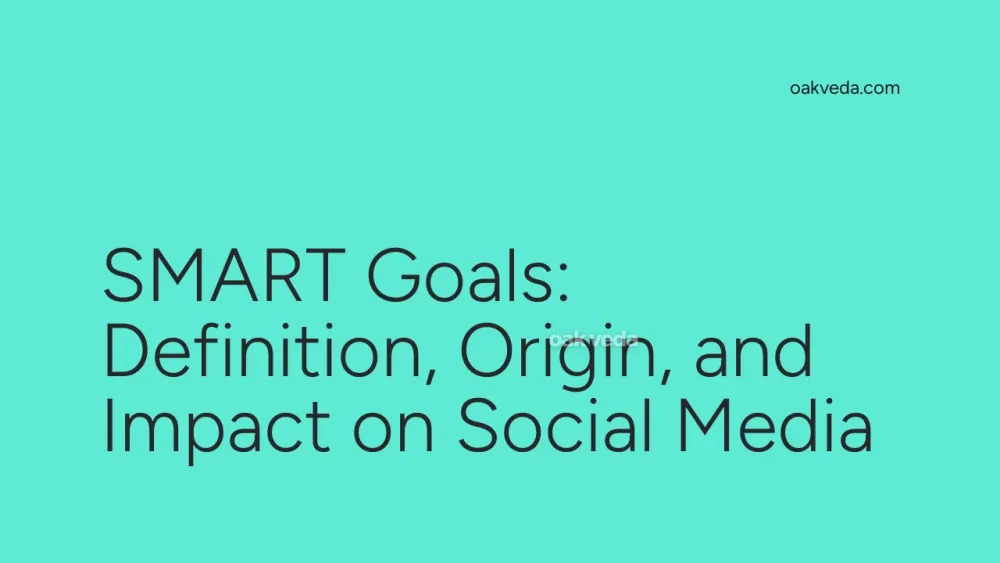
What are SMART Goals?
SMART Goals are a strategic framework used for setting clear, actionable objectives in various fields, including social media marketing. The acronym SMART stands for Specific, Measurable, Achievable, Relevant, and Time-bound. This goal-setting approach helps individuals and organizations create well-defined targets that increase the likelihood of success.
Origin and Development of SMART Goals
The SMART criteria were first introduced by George T. Doran in a 1981 issue of Management Review. Initially developed for business management, the concept has since been widely adopted across various industries and disciplines, including social media marketing and digital strategy.
How SMART Goals Work
SMART Goals work by breaking down objectives into five key components:
- Specific: Goals should be clear and precise, leaving no room for ambiguity.
- Measurable: Objectives must have quantifiable metrics to track progress.
- Achievable: Goals should be realistic and attainable given available resources.
- Relevant: Objectives must align with broader business or personal goals.
- Time-bound: Goals should have a defined timeframe for completion.
By incorporating these elements, SMART Goals provide a structured approach to goal-setting that enhances focus, motivation, and accountability.
Types of SMART Goals in Social Media
In the context of social media, SMART Goals can be applied to various aspects of digital marketing:
- Engagement Goals: Increasing likes, comments, or shares
- Audience Growth Goals: Expanding follower count or reach
- Conversion Goals: Boosting click-through rates or lead generation
- Brand Awareness Goals: Improving brand mentions or sentiment
- Content Performance Goals: Enhancing post visibility or video views
Popular Examples of SMART Goals in Social Media
Let's examine some SMART Goal examples for social media:
- "Increase Instagram followers by 20% (from 10,000 to 12,000) within the next three months through daily posting and engagement strategies."
- "Boost Twitter engagement rate from 2% to 3.5% by the end of Q2 by implementing a new content calendar and responding to 90% of mentions within 2 hours."
- "Generate 500 qualified leads from LinkedIn advertising campaigns by the end of the fiscal year, with a budget of $5,000 and a target cost-per-lead of $10."
Impact of SMART Goals on Social Media Culture
SMART Goals have significantly influenced social media culture by:
- Promoting Data-Driven Strategies: Encouraging marketers to rely on analytics and metrics for decision-making.
- Enhancing Accountability: Creating clear benchmarks for success in social media campaigns.
- Improving Resource Allocation: Helping teams prioritize efforts and budget based on specific objectives.
- Fostering Agile Marketing: Enabling quick adjustments to strategies based on measurable outcomes.
- Aligning Social Media with Business Objectives: Ensuring social media efforts contribute to overall organizational goals.
How Brands and Influencers Use SMART Goals
Brands and influencers leverage SMART Goals to optimize their social media presence:
- Content Planning: Creating targeted content strategies aligned with specific objectives.
- Campaign Measurement: Setting clear KPIs for social media campaigns and promotions.
- Audience Growth: Developing structured plans for expanding reach and engagement.
- ROI Tracking: Measuring the effectiveness of social media investments against defined targets.
- Performance Improvement: Identifying areas for enhancement based on quantifiable metrics.
Future Trends Related to SMART Goals in Social Media
As social media continues to evolve, SMART Goals are adapting to new trends:
- AI-Driven Goal Setting: Utilizing artificial intelligence to suggest and refine SMART Goals based on historical data and industry benchmarks.
- Real-Time Goal Adjustment: Implementing dynamic goals that adapt to changing market conditions and platform algorithms.
- Cross-Platform Goal Integration: Creating cohesive SMART Goals that span multiple social media platforms for a unified strategy.
- Personalized Goal Recommendations: Tailoring SMART Goals to individual user behaviors and preferences for more targeted marketing.
- Sustainability Goals: Incorporating environmental and social responsibility metrics into SMART social media objectives.
FAQs about SMART Goals in Social Media
-
How often should I review my SMART Goals? Review your SMART Goals regularly, at least quarterly, to ensure they remain relevant and achievable.
-
Can SMART Goals be applied to personal social media use? Yes, individuals can use SMART Goals to manage their personal brand, grow their network, or achieve specific social media-related objectives.
-
What tools can help track SMART Goals in social media? Popular tools include Google Analytics, Hootsuite, Sprout Social, and platform-specific analytics like Facebook Insights or Twitter Analytics.
-
How do I balance multiple SMART Goals across different social media platforms? Prioritize goals based on your overall strategy, allocate resources accordingly, and use a unified dashboard to track progress across platforms.
-
What if I don't achieve my SMART Goal? Analyze the reasons for not meeting the goal, learn from the experience, and adjust your future goals or strategies accordingly.
By implementing SMART Goals in social media strategies, marketers, brands, and influencers can create more focused, effective, and measurable campaigns. This framework not only improves performance but also fosters a culture of continuous improvement and data-driven decision-making in the dynamic world of social media marketing.
You may be interested in:
- Social Proof: Definition, Origin, and Impact on Digital Marketing
- Instagram Carousel: Definition, Origin, and Impact
- Coded: Definition, Origin, and Impact on Social Media
- Extra: Definition, Origin, and Impact on Social Media
- Social Media Automation: Definition, Origin, and Impact
- Beige Flag: Definition, Origin, and Impact on Social Media

